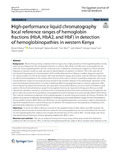| dc.description.abstract | Background
Western Kenya, being a malaria-endemic region, has a high prevalence of hemoglobinopathies mostly sickle cell and thalassemia. The hemoglobin fractions or variants, HbA, HbA2, and HbF, serve as biomarkers for the detection of hemoglobinopathies and are commonly used in laboratory screening and diagnosis of these diseases. Diagnosis of diseases entails accurate and precise representation of a patient’s condition. This is the main aim of International Organization for Standardization (ISO) certified laboratories of offering a reliable diagnostic guide for the various diseases. For this to be realized, valid normal reference ranges are required. Such are reference values that are valid for local population of the setting where they are to be used is critical in quantitative diagnostic tests. Local normal reference ranges are necessary because research has revealed variations in the phenotypic expression of the genes for biological characteristics in humans inhabiting different geographical regions, owing to epigenetic differences imposed by physical environments, and associated sociocultural influences, even in cases of similarity in gene patterns. No local normal reference ranges for hemoglobin fractions are reported for Kenya and Africa as a whole. Laboratories therefore continue to use those found in textbooks and brochures from manufacturers of diagnostic reagents, which are derived from populations of geographical locations faraway and socioculturally different from Kenya. This could be misleading in diagnosis of hemoglobinopathies in western Kenya and indeed all of Kenya. Therefore, the present study aimed at exploring the possibility of developing local normal reference ranges for the concentrations of hemoglobin fractions, HbA, HbA2, and HbF, based on hemoglobinopathy-free, non-anemic subjects attending the Aga Khan Hospital Kisumu in western Kenya and its satellites. The hospital serves the populations inhabiting in and predominantly indigenous to western Kenya.
Objectives
To derive the 95% confidence intervals for hemoglobin fractions (HbA, HbA2, and HbF), evaluate the potential of these intervals as normal reference values for the local population by use of concentrations for non-anemic hemoglobinopathy-free subjects and compare the performance of the current HPLC normal ranges with those intervals we derived, based on receiver operating characteristic (ROC) curve.
Materials and methods
This was an analytical retrospective study using routine assay results from laboratory database for 386 non-anemic, HPLC-confirmed hemoglobinopathy-free subjects. Blood samples were obtained at the Kisumu Aga Khan Hospital and its satellite sites in western Kenya, covering January 2015 to November 9, 2021. The data for Hb fractions were nonparametric, and so confidence intervals, together with the age of subjects, were thus expressed as the median and interquartile range (IQR). Data for the gender and other characteristics of study subjects were summarized in frequencies and proportions, Kruskal-Wallis H-test was used to test the significance of differences in Hb concentrations between stations and age groups, while Mann-Whitney U-test is between males and females. The receiver operating characteristic (ROC) curve was used to evaluate the potential of the derived confidence intervals as normal reference values in comparison with the commonly used normal values for hemoglobin fractions.
Results
The potential normal reference intervals were computed as 95% confidence intervals (CI) for median percentage levels for the concentrations of the Hb fractions HbA, HbA2, and HbF for the hemoglobinopathy-free patients. The overall confidence intervals were derived first for the combined sample of all the hemoglobinopathy-free patients combined together irrespective station where blood specimens were obtained, age or gender, and then followed by those for separate groups, stratified based on station, age, and gender. The overall median values for the hemoglobin fractions were hemoglobin: A (HbA) 87.7, IQR = 5.7, 95% CI = 76.3–99.1; hemoglobin A2 (HbA2), 3.0, IQR = 0.6; 95% CI = 1.8–4.2; and hemoglobin F (HbF), 0.8, IQR = 0.8; 95% CI = 0.00–2.4, with the P window, 4.98, IQR = 0.4; 95% CI = 4.18–5.78. The commonly used normal reference ranges for the hemoglobin fractions were as follows: HbA 95–98%, had an accuracy of 57.5%, HbA2 of 1.5–3.5%, had an accuracy of 95.9% in grading the presumed healthy population as hemoglobinopathy-free, while HbF 0–2.0 was equal to that established by the present study.
Conclusion
It is important to report that the use of normal range for HbA of 95–98% published by Kratz et al. [1] in western Kenya has a potential threat of misdiagnosis of normal population and thus needs urgent review as it lacked efficacy (p = 0.795) in grading hemoglobinopathy-free subjects as normal with a poor accuracy of 57.5%, a sensitivity of 100%, specificity of 0.3%, positive predictive validity of 15.1%, negative predictive validity of 1%, and 1.03 positive likelihood ratio. However, the traditional normal range for HbA2 of 1.5–3.5% on use in western Kenya may be retained as it was effective (p < 0.0001) in grading majority of study subjects as normal with an accuracy of 95.9%, sensitivity of 98.4%, specificity of 93.3%, positive predictive validity of 99.7%, negative predictive validity of 70.0%, 14.7 positive likelihood ratio, and 0.017 negative likelihood ratio. Similarly, the existing normal range for HbF of 0–2.0 on use was almost the same as the one we derived of 0–2.4 and therefore may be retained for use in western Kenya. It is anticipated that the finding of this study will help improve the management of hemoglobinopathies in Kenya and Africa at large, by contributing to improvement in the validity of the clinical-pathologic interpretation assay results for the percentage values for the Hb fractions. | en_US |

